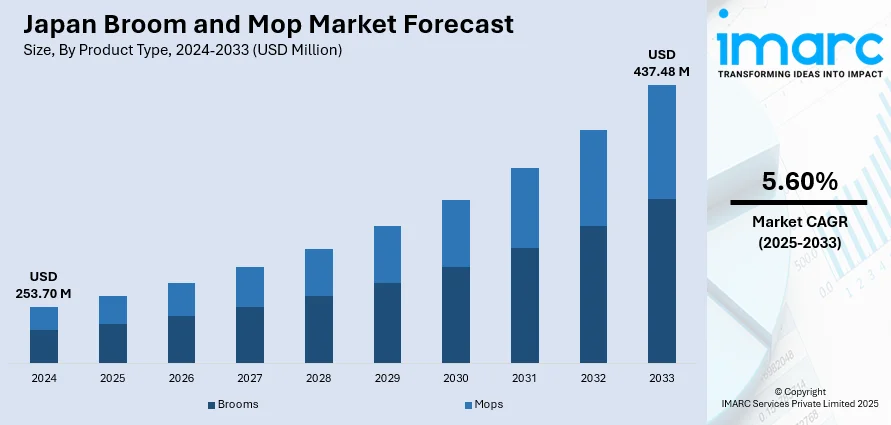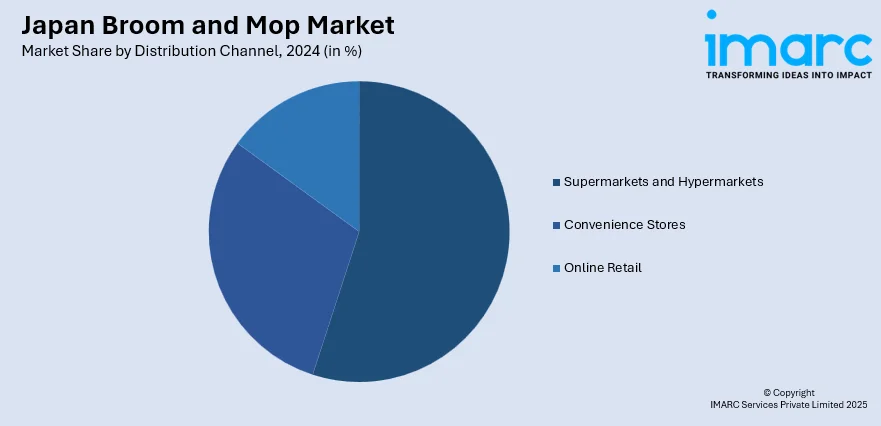
Japan Broom and Mop Market Size, Share, Trends and Forecast by Product Type, Distribution Channel, and Region, 2025-2033
Japan Broom and Mop Market Overview:
The Japan broom and mop market size reached USD 253.70 Million in 2024. Looking forward, IMARC Group expects the market to reach USD 437.48 Million by 2033, exhibiting a growth rate (CAGR) of 5.60% during 2025-2033. The market is witnessing steady growth due to urbanization, increased hygiene awareness, and evolving consumer preferences for convenience. Innovative designs, eco-friendly materials, and technological advancements in cleaning tools are also driving the market. The integration of artificial intelligence has led to the introduction of robotic mops that offer convenience through the automation of cleaning, thus further contributing to Japan broom and mop market share.
|
Report Attribute
|
Key Statistics
|
|---|---|
|
Base Year
|
2024
|
|
Forecast Years
|
2025-2033
|
|
Historical Years
|
2019-2024
|
| Market Size in 2024 | USD 253.70 Million |
| Market Forecast in 2033 | USD 437.48 Million |
| Market Growth Rate 2025-2033 | 5.60% |
Japan Broom and Mop Market Trends:
Increasing Demand for Eco-Friendly Products
In Japan, eco-friendly broom and mop products are gaining popularity as consumers become increasingly environmentally conscious. Sustainable, biodegradable, and recyclable cleaning equipment is in high demand, fueled by plastic waste and environmental pollution concerns. Numerous consumers are enthusiastically shopping for cleaning products made from natural fibers like bamboo or cotton, which are not only long-lasting but also naturally decomposable. In line with this, environmentally friendly cleaning products like reusable mop pads and energy-saving steam mops are becoming increasingly popular. Brands are catching up with this trend by creating products containing less plastic and more renewable resources in line with Japan's emphasis on sustainability. This move towards greener solutions is additionally facilitated by government programs and consumer education campaigns encouraging environmental stewardship. Consequently, environmentally friendly products are likely to gain a greater share of the Japanese mop and broom market.

Technological Advancements
Technological advancements have contributed significantly toward the broom and mop industry in Japan with high-tech products such as steam mops and automatic mops becoming popular. Steam mops that apply high-temperature steam to sanitize and clean surfaces with minimal or no chemicals are especially appealing to consumers who prioritize health. Such mops are not only an environmentally friendly cleaning method but also sanitize deeper, taking into consideration fears of germs and allergens. Robotic mops, on the other hand, offer convenience through the automation of cleaning. These smart devices can move around obstacles, clean several surfaces, and be operated remotely through mobile applications saving time and effort for users. The use of artificial intelligence (AI) and sensors in robotic mops improves their efficiency in cleaning and accessing areas that are normally hard to reach. With these innovations the Japanese market is witnessing a shift towards more efficient and user-friendly cleaning solutions, which in turn, drives the Japan broom and mop market growth.
Compact and Space-Saving Designs
As urbanization continues to shape Japan’s living environment, the demand for compact and space-saving cleaning tools has risen. With smaller apartments and limited storage space becoming the norm, consumers are increasingly seeking cleaning products that offer high performance while taking up minimal room. Brooms and mops are now being designed to be lightweight, foldable, and easily storable. Manufacturers are introducing products with telescopic handles, slim profiles, and detachable parts that can be neatly stored in small cabinets or closets. These space-efficient designs make it easier for city dwellers to maintain cleanliness without sacrificing space for bulky cleaning tools. Additionally, multifunctional products that combine brooms, mops, and dusters into one compact tool are gaining traction. This trend reflects the broader lifestyle shift in Japan towards maximizing the use of limited living space where efficiency and convenience in everyday household products are prioritized.
Japan Broom and Mop Market Segmentation:
IMARC Group provides an analysis of the key trends in each segment of the market, along with forecasts at the country and regional levels for 2025-2033. Our report has categorized the market based on product type and distribution channel.
Product Type Insights:
- Brooms
- Mops
The report has provided a detailed breakup and analysis of the market based on the product type. This includes brooms and mops.
Distribution Channel Insights:

- Supermarkets and Hypermarkets
- Convenience Stores
- Online Retail
A detailed breakup and analysis of the market based on the distribution channel have also been provided in the report. This includes supermarkets and hypermarkets, convenience stores, and online retail.
Regional Insights:
- Kanto Region
- Kansai/Kinki Region
- Central/Chubu Region
- Kyushu-Okinawa Region
- Tohoku Region
- Chugoku Region
- Hokkaido Region
- Shikoku Region
The report has also provided a comprehensive analysis of all the major regional markets, which include Kanto Region, Kansai/Kinki Region, Central/Chubu Region, Kyushu-Okinawa Region, Tohoku Region, Chugoku Region, Hokkaido Region, and Shikoku Region.
Competitive Landscape:
The market research report has also provided a comprehensive analysis of the competitive landscape. Competitive analysis such as market structure, key player positioning, top winning strategies, competitive dashboard, and company evaluation quadrant has been covered in the report. Also, detailed profiles of all major companies have been provided.
Japan Broom and Mop Market Report Coverage:
| Report Features | Details |
|---|---|
| Base Year of the Analysis | 2024 |
| Historical Period | 2019-2024 |
| Forecast Period | 2025-2033 |
| Units | Million USD |
| Scope of the Report |
Exploration of Historical Trends and Market Outlook, Industry Catalysts and Challenges, Segment-Wise Historical and Future Market Assessment:
|
| Product Types Covered | Brooms, Mops |
| Distribution Channels Covered | Supermarkets and Hypermarkets, Convenience Stores, Online Retail |
| Regions Covered | Kanto Region, Kansai/Kinki Region, Central/Chubu Region, Kyushu-Okinawa Region, Tohoku Region, Chugoku Region, Hokkaido Region, Shikoku Region |
| Customization Scope | 10% Free Customization |
| Post-Sale Analyst Support | 10-12 Weeks |
| Delivery Format | PDF and Excel through Email (We can also provide the editable version of the report in PPT/Word format on special request) |
Key Questions Answered in This Report:
- How has the Japan broom and mop market performed so far and how will it perform in the coming years?
- What is the breakup of the Japan broom and mop market on the basis of product type?
- What is the breakup of the Japan broom and mop market on the basis of distribution channel?
- What is the breakup of the Japan broom and mop market on the basis of region?
- What are the various stages in the value chain of the Japan broom and mop market?
- What are the key driving factors and challenges in the Japan broom and mop?
- What is the structure of the Japan broom and mop market and who are the key players?
- What is the degree of competition in the Japan broom and mop market?
Key Benefits for Stakeholders:
- IMARC’s industry report offers a comprehensive quantitative analysis of various market segments, historical and current market trends, market forecasts, and dynamics of the Japan broom and mop market from 2019-2033.
- The research report provides the latest information on the market drivers, challenges, and opportunities in the Japan broom and mop market.
- Porter's five forces analysis assist stakeholders in assessing the impact of new entrants, competitive rivalry, supplier power, buyer power, and the threat of substitution. It helps stakeholders to analyze the level of competition within the Japan broom and mop industry and its attractiveness.
- Competitive landscape allows stakeholders to understand their competitive environment and provides an insight into the current positions of key players in the market.
Need more help?
- Speak to our experienced analysts for insights on the current market scenarios.
- Include additional segments and countries to customize the report as per your requirement.
- Gain an unparalleled competitive advantage in your domain by understanding how to utilize the report and positively impacting your operations and revenue.
- For further assistance, please connect with our analysts.
 Request Customization
Request Customization
 Speak to an Analyst
Speak to an Analyst
 Request Brochure
Request Brochure
 Inquire Before Buying
Inquire Before Buying




.webp)




.webp)












